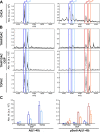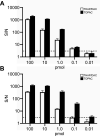Matrix Development for the Detection of Phosphorylated Amyloid-β Peptides by MALDI-TOF-MS
- PMID: 36706152
- PMCID: PMC9983008
- DOI: 10.1021/jasms.2c00270
Matrix Development for the Detection of Phosphorylated Amyloid-β Peptides by MALDI-TOF-MS
Abstract
Amyloid-β (Aβ) peptides, including post-translationally modified variants thereof, are believed to play a key role in the onset and progression of Alzheimer's disease. Suggested modified Aβ species with potential disease relevance include Aβ peptides phosphorylated at serine in position eight (pSer8-Aβ) or 26 (pSer26-Aβ). However, the published studies on those Aβ peptides essentially relied on antibody-based approaches. Thus, complementary analyses by mass spectrometry, as shown for other modified Aβ variants, will be necessary not only to unambiguously verify the existence of phosphorylated Aβ species in brain samples but also to reveal their exact identity as to phosphorylation sites and potential terminal truncations. With the aim of providing a novel tool for addressing this still-unresolved issue, we developed a customized matrix formulation, referred to as TOPAC, that allows for improved detection of synthetic phosphorylated Aβ species by matrix-assisted laser desorption/ionization time-of-flight mass spectrometry. When TOPAC was compared with standard matrices, we observed higher signal intensities but minimal methionine oxidation and phosphate loss for intact pSer8-Aβ(1-40) and pSer26-Aβ(1-40). Similarly, TOPAC also improved the mass spectrometric detection and sequencing of the proteolytic cleavage products pSer8-Aβ(1-16) and pSer26-Aβ(17-28). We expect that TOPAC will facilitate future efforts to detect and characterize endogenous phosphorylated Aβ species in biological samples and that it may also find its use in phospho-proteomic approaches apart from applications in the Aβ field.
Conflict of interest statement
The authors declare no competing financial interest.
Figures



Similar articles
-
Quantitative Assessment of Serine-8 Phosphorylated β-Amyloid Using MALDI-TOF Mass Spectrometry.Molecules. 2022 Dec 1;27(23):8406. doi: 10.3390/molecules27238406. Molecules. 2022. PMID: 36500498 Free PMC article.
-
Unveiling Brain Aβ Heterogeneity Through Targeted Proteomic Analysis.Methods Mol Biol. 2018;1779:23-43. doi: 10.1007/978-1-4939-7816-8_3. Methods Mol Biol. 2018. PMID: 29886525 Free PMC article.
-
Probing amyloid-β pathology in transgenic Alzheimer's disease (tgArcSwe) mice using MALDI imaging mass spectrometry.J Neurochem. 2016 Aug;138(3):469-78. doi: 10.1111/jnc.13645. Epub 2016 May 26. J Neurochem. 2016. PMID: 27115712
-
Stoichiometry of Heavy Metal Binding to Peptides Involved in Alzheimer's Disease: Mass Spectrometric Evidence.Adv Exp Med Biol. 2019;1140:401-415. doi: 10.1007/978-3-030-15950-4_23. Adv Exp Med Biol. 2019. PMID: 31347061 Review.
-
Mass spectrometric studies of the variety of beta-amyloid proteoforms in Alzheimer's disease.Mass Spectrom Rev. 2022 Mar 28:e21775. doi: 10.1002/mas.21775. Online ahead of print. Mass Spectrom Rev. 2022. PMID: 35347731 Review.
Cited by
-
Quantitative mass spectrometry imaging: therapeutics & biomolecules.Chem Commun (Camb). 2024 Feb 20;60(16):2137-2151. doi: 10.1039/d3cc05988j. Chem Commun (Camb). 2024. PMID: 38284765 Free PMC article. Review.
References
-
- Portelius E.; Bogdanovic N.; Gustavsson M. K.; Volkmann I.; Brinkmalm G.; Zetterberg H.; Winblad B.; Blennow K. Mass spectrometric characterization of brain amyloid beta isoform signatures in familial and sporadic Alzheimer’s disease. Acta Neuropathol 2010, 120 (2), 185–193. 10.1007/s00401-010-0690-1. - DOI - PMC - PubMed
MeSH terms
Substances
LinkOut - more resources
Full Text Sources
Medical

